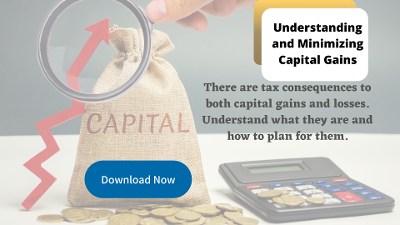You are now leaving the Chase Investment Counsel website and entering the Chase Growth Fund website.

Minimizing Capital Gains
Minimizing Capital Gains
The act of investing – putting aside money today and buying an asset like a house, or stock – generally has one main goal in mind – capital gains. Capital gains can apply to any type of asset: a home, a stock, a bond and even a collectible like a rare coin. Usually, we buy assets with the hope that they appreciate over time. There are tax consequences to both capital gains and losses that are important for investors to know. You’ll be hearing a lot about capital gains as you prepare your 2022 taxes. While it may be too late to do much about those now, perhaps this article, which explains strategies to reduce the tax you pay on capital gains, will help you plan for 2023.
Capital Gains Tax Strategies
While realizing a capital gain means that you made money on a stock, you still need to pay taxes on that realized gain. Once a gain is realized, the only way to avoid paying taxes on it is to offset the gain with a realized loss. We’ll take a look at how to minimize capital gains both after realizing the gain (through a process known as tax-loss harvesting) as well as before realizing the gain (through gifting or charitable donation).
Tax-Loss Harvesting
It’s a well-known practice even for those who don’t use the term, but tax-loss harvesting is simply the process of realizing capital losses in order to offset capital gains. Tax-loss harvesting is usually done near the end of the fiscal year as people begin to pay closer attention to their future tax situation and look for ways to minimize their tax bill.
In the past, tax-loss harvesting happened almost exclusively during the end of December, but as investors have recognized the need to begin their tax planning earlier, tax-loss harvesting often happens earlier in the year. There are advantages to planning things out before the end of the year. By recognizing losses earlier, investors have the opportunity to buy back the stock before the end of the year without triggering the wash sale rule.
Gifting Stock
Gifting a stock to someone else is a way for you to avoid paying taxes on the gain. In 2023, the annual gift tax exclusion is $17,000/recipient, so you could give up to $17,000 worth of stock to someone without delving into the lifetime estate tax exemption ($12.92 million in 2023). If you gift a stock instead of selling it, you avoid realizing a gain in the stock. So how does this play out in real life?
Assume you bought Stock XYZ ten years ago for $3,000, and today it is worth $10,000. If you wanted to give your nephew $10,000, you could sell the stock and realize $7,000 in long-term capital gains (paying tax on that gain), then write him a check for $10,000. However, if you gift him the stock instead, you avoid paying taxes on the gain, leaving it up to him as to when he wants to sell it and realize a gain. When you gift a stock, the recipient inherits your cost basis, so in this scenario, your nephew would now have stock worth $10,000 with a cost basis of $3,000.
By gifting an appreciating asset, you can avoid paying the capital gains on it, and the recipient can either sell it and pay taxes on the gain or allow the asset to (hopefully) continue to increase in value. Note that if you have a loss in the stock, it makes more sense for you to sell the stock, realizing the loss, then gifting the proceeds to the recipient.
Charitable Donation of Stock
Another way to avoid realizing gains on a stock is to gift it to a charity. If the stock that you gift has a long-term capital gain, you avoid recognizing a gain on the sale while at the same time being able to deduct the entire fair market value of the stock. Especially when you are in a high tax bracket, this can be incredibly beneficial, as demonstrated below.
Let’s assume that you are in the highest tax bracket of 37%, with taxable income of $1,000,000. In this scenario, you have Stock XYZ that you bought 10 years ago for $10,000 which is now worth $100,000, and you want to give $100,000 to a charity. If you sold Stock XYZ and gave the $100,000 to charity, you would realize a $90,000 long-term capital gain and have a $100,000 charitable deduction. The charitable deduction would save you $37,000 in taxes (assuming the 37% tax rate), but you would owe $18,000 on your realized gain, resulting in tax savings of $19,000.
What if instead of selling Stock XYZ, you gifted it directly to the charity? You no longer realize a gain, but you are still able to deduct the full fair market value of $100,000. By donating the stock directly to charity, you would save $37,000 in taxes as opposed to the $19,000 in the first scenario.
How to Get Started
If you own a lot of stocks and are an active trader, trying to keep track of capital gains be a daunting task. By working with a professional financial adviser, they can help keep track of your tax situation and give you clear, objective advice to ensure that your financial goals are met. Find someone that you’re comfortable with and let them help you on your financial journey.
About Chase Investment Counsel
Chase Investment Counsel is a family and employee-owned boutique wealth management firm that offers personalized investment services. Our clients include career professionals, those nearing or in retirement, and families experiencing financial transitions such as generational wealth transfer, widowhood, divorce, or sale of a business. Chase’s active, disciplined investment management team is focused on selecting individual stocks and bonds targeted to each investor’s specific financial goals and risk tolerance. Established in 1957 in Charlottesville, VA, Chase Investment Counsel manages more than $300 million in assets.
